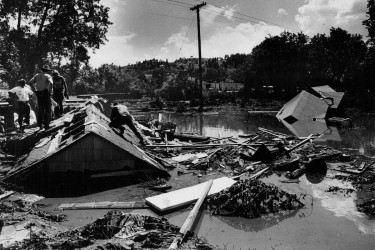White’s filmmaking initially helped him escape the weight of Wounded Knee’s histories—his first film was a short about New Zealand, inspired by his love of Lord of the Rings, that was shot on his father’s hunting camera. But if stories and films offer creative and intellectual freedom, the heavy histories, places, and experiences from which they spring also inspire him and keep him grounded here, rather than setting out for Los Angeles or Brooklyn. White wants one of his future projects to be about the dueling legacies of Wounded Knee—the massacre and the liberation. He hopes to focus on the lesser-known aspects of these struggles, and at Red Cloud, he has access to archival photos of memorializations of the carnage as well as images of some ceremonies held here over generations. He also intends to put the lives of the women in AIM, like Madonna Thunder Hawk, who are often overlooked in favor of men, at the center of the narrative.
On Sunday, as we ascended the hill at Wounded Knee, White told me about his relative Swift Bird, who was killed and buried alongside Big Foot and the Ghost Dancers. At the top of the hill, we happened to run into Jeff Moreno, the son of American Indian Movement (AIM) leader Dennis Banks, who helped lead the takeover. “We were the prophets, the messengers, the fire-starters,” Banks wrote in his autobiography, Ojibwa Warrior, cowritten with Richard Erdoes. “Out of AIM came a new breed of writers, poets, artists, actors, and filmmakers.”
“We figured we’d come here and pay our respects,” Moreno said, accompanied by his wife Melinda and daughter Jordilyn, whose hair was tied in pigtails.
After Moreno departed, White and I spent a few minutes there, surveying the ground, still searching for meaning.
“It gets me really reflective—just the different things that our people have been through,” White said. “I’m constantly reminded about things like this, events like this, that really shaped our history, shaped our communities, and how that’s evolved into some of the challenges that we face today.”
Wounded Knee holds both the bloody abyss and the unconquered vision of this continent’s First Peoples. It is the site of a massacre and of the Independent Oglala Nation. Both stories are ours equally: genocide and its aftershocks in the climate; the Ghost Dance, the American Indian Movement, and the campaign against the Keystone XL pipeline. Some days, I feel we have been condemned to the most wretched fate of any people—a slow, painful, and intergenerational death. But then, I see our people rising. And sometimes I see both at once, in the same frame, and in the same place. As the climate breaks down, we remain caught between both legacies of Wounded Knee—genocide and freedom—the horror of the massacre and the dream of the massacred.












